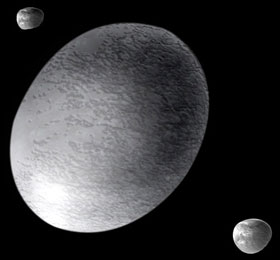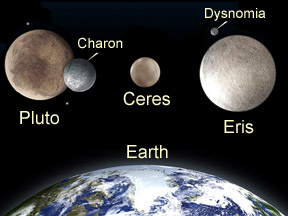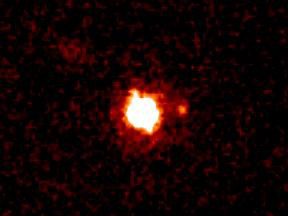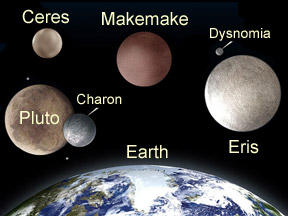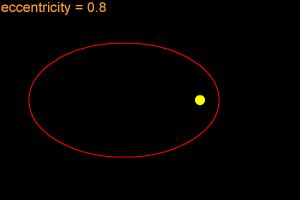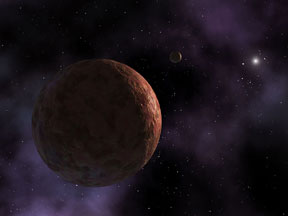Click on image for full size
Images courtesy of NASA, ESA, and A. Feild (STScI).
Haumea (dwarf planet)
Haumea is a dwarf planet in our Solar System. Haumea is officially the fifth dwarf planet. The four that came before it are Pluto, Eris, Ceres, and Makemake. Haumea was classified a dwarf planet in September 2008.
Haumea is a large Kuiper Belt Object (KBO). It is an icy world that orbits far from the Sun on the frozen fringes of our Solar System. Because it is so far away, Haumea takes 285 years to orbit the Sun once! Haumea is usually a bit further from the Sun than Pluto.
Haumea is smaller than both Pluto and Eris. Haumea has an odd shape. It is not a sphere. It is spinning so quickly that it has been stretched into the shape of an ellipsoid (a 3D ellipse). Haumea is 1,960 km (1,218 miles) across at its longest. It is only about half that far across - 996 km (619 miles) - along its shortest axis.
The "days" are really short on Haumea. This weird object spins around in less than four hours! Haumea is fairly dense. That means it is probably made mostly of rock. Most other KBOs probably have more ice in them than Haumea. This dwarf planet has known moons, both discovered in 2005. Their names are Hi'iaka and Namaka.
Astronomers think Haumea collided with another large object a long time ago. A collision like that might explain Haumea's strange shape and why it spins so fast. The big collision might have knocked away most of Haumea's lightweight ice, leaving behind heavier rock. Haumea's moons may be leftover stuff from the collision.
In the mythology of Hawaii, Haumea is the goddess of fertility and childbirth. Her children include Hi'iaka and Namaka, as well as the Hawaiian volcano and fire goddess Pele.
There are two different groups that might get credit for discovering Haumea. One group is led by Mike Brown of the California Institute of Technology. The other group's leader is José Luis Ortiz Moreno at the Sierra Nevada Observatory in Spain. Haumea was discovered sometime between March 2003 and July 2005.
Haumea was called 2003 EL61 before it got its official, permanent name. It had been nicknamed "Santa" by Brown's group because they discovered it near Christmas in 2004.


